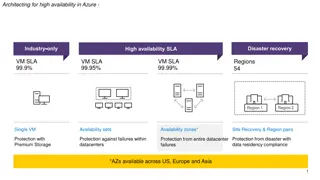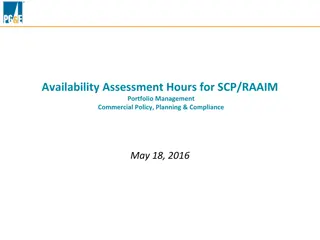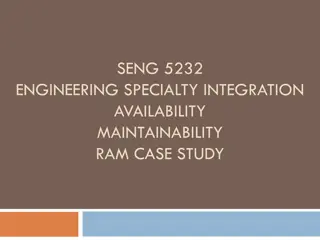Achieving High Availability with DB2 HADR
Explore the concept of High Availability Disaster Recovery (HADR) in DB2, including its introduction in version 8.2, log-based replication, and its benefits for ensuring High Availability (HA) and Disaster Recovery (DR) at remote data centers. Learn about HADR's bundling with all DB2 versions (except Express-C), synchronization modes, configuring databases for HADR, and the importance of choosing the right HADR synchronization mode based on business requirements.
Download Presentation

Please find below an Image/Link to download the presentation.
The content on the website is provided AS IS for your information and personal use only. It may not be sold, licensed, or shared on other websites without obtaining consent from the author. Download presentation by click this link. If you encounter any issues during the download, it is possible that the publisher has removed the file from their server.
E N D
Presentation Transcript
Achieving High Availability with DB2 HADR and TSAMP Philip K. Gunning Gunning Technology Solutions, LLC
What is HADR? High Availability Disaster Recovery (HADR) Introduced in DB2 V8.2 Log based replication using existing network infrastructure Ported from Informix after acquired by IBM Provides for High Availability (HA) in same data center or Disaster Recovery (DR) at remote data center Many improvements over the years based on customer feedback and technology improvements
HADR Bundled with all versions of DB2 except DB2 Express-C Easy to setup and monitor Provides additional flexibility for report only databases while providing a degree of high availability Multiple synchronous modes to choose some Synchronization mode should be chosen based on BUSINESS REQUIREMENTS Many times the business doesn t know there requirements That s where you provide recommendations based on analysis of application requirements
HADR Overview Primary Standby HADR Recv buffer HADR Send buffer TCPIP Log spool PRDDB Log Replay Agents Log writer PRDDB LOG LOG LOG New York Atlanta
Configuring Databases for HADR Before you can use HADR you have to determine the SYNC mode you will use and then create a template of ports, service names, and IP addresses you will use You normally need to coordinate this with network support personnel or server ADMINS Properly size the STANDBY server or servers The primary STANDBY should have same amount of RAM and CPU as the primary in the event of a failover or takeover (for takeover purposes and log replay agents) It is recommended that the hardware be identical
Synchronization Modes hadr_syncmode Database Configuration Parameter that controls the HADR synchronization mode Four possible values: SYNC NEARSYNC ASYNC SUPERASYNC
Hadr_syncmode SYNC Mode (Think LAN) SYNC mode offers the best protection of data. Two on- disk copies of data are required for transaction commit. The cost is the extra time for writing on the standby and sending an acknowledgment message back to the primary. In SYNC mode, logs are sent to the standby only after they are written to the primary disk. Log write and replication events happen sequentially. The total time for a log write event is the sum of (primary_log_write + log_send + standby_log_write + ack_message). The communication overhead of replication in this mode is significantly higher than that of the other three modes.
Hadr_syncmode NEARSYNC Mode (Think LAN) NEARSYNC mode is nearly as good as SYNC, with significantly less communication overhead. In NEARSYNC mode, sending logs to the standby and writing logs to the primary disk are done in parallel, and the standby sends an acknowledgement message as soon as it receives the logs in memory. On a fast network, log replication causes no or little overhead to primary log writing. In NEARSYNC mode, you will lose data if the primary fails and the standby fails before it has a chance to write the received logs to disk. This is a relatively rare "double failure" scenario. Thus NEARSYNC is a good choice for many applications, providing near synchronization protection at far less performance cost.
Hadr_syncmode ASYNC Mode (Think WAN) In ASYNC mode, sending logs to the standby and writing logs to the primary disk are done in parallel, just like in NEARSYNC mode. Because ASYNC mode does not wait for acknowledgment messages from the standby, the primary system throughput is min(log write rate, log send rate). ASYNC mode is well suited for WAN applications. Network transmission delay does not impact performance in this mode, but if the primary database fails, there is a higher chance that logs in transit will be lost (not replicated to standby).
Hadr_syncmode SUPERASYNC Mode (Think WAN) This mode has the shortest transaction response time of all synchronization modes but has also the highest probability of transaction losses if the primary system fails. The primary system throughput is only affected by the time needed to write the transaction to the local disk. This mode is useful when you do not want transactions to be blocked or experience elongated response times due to network interruptions or congestion. SUPERASYNC mode is well suited for WAN applications. Since the transaction commit operations on the primary database are not affected by the relative slowness of the HADR network or the standby HADR server, the log gap between the primary database and the standby database might continue to increase. It is important to monitor the log gap in this mode as it is an indirect measure of the potential number of transactions that might be lost should a true disaster occur on the primary system.
Hadr_syncmode Summary SYNC: Log Write on primary requires replication to the persistent storage on the standby (Think LAN) NEARSYNC: Log write on primary requires replication to the memory on the standby (Think LAN) ASYNC: Log write on primary requires a successful send to standby (receive is not guaranteed) (Think WAN) SUPERASYNC: Log Write on primary has no dependency on replication to standby (Think WAN)
Configuring Databases for HADR Setup separate dedicated NETWORK for HADR PRIMARY to SECONDARY connection Open HADR ports in Firewalls else HADR will fail and can be difficult to diagnose!
HADR Design RECAP Before you can use HADR you have to determine the SYNC mode you will use and then create a template of ports, service names, and IP addresses you will use Create a diagram of the proposed architecture, so all involved have a common picture of the setup Helps to avoid confusion and misconceptions!
DB CFG HADR Parameters -- Primary HADR local host name (HADR_LOCAL_HOST) = 10.221.37.1 HADR local service name (HADR_LOCAL_SVC) = db2h_DB2_1 HADR remote host name (HADR_REMOTE_HOST) = 10.221.37.2 HADR remote service name (HADR_REMOTE_SVC) = db2h_DB2_2 HADR instance name of remote server (HADR_REMOTE_INST) = DB2 HADR timeout value (HADR_TIMEOUT) = 120 HADR log write synchronization mode (HADR_SYNCMODE) = SUPERASYNC HADR peer window duration (seconds) (HADR_PEER_WINDOW) = 600
/ETC/SERVICES Entries -- Primary db2h_DB2_1 58101/tcp HADR GCPROD Port db2h_DB2_2 58102/tcp HADR GCPROD Port #DB2 #DB2
DB CFG HADR Parameters -- Standby HADR local host name (HADR_LOCAL_HOST) = 10.221.37.2 HADR local service name (HADR_LOCAL_SVC) = db2h_DB2_2 HADR remote host name (HADR_REMOTE_HOST) = 10.221.37.1 HADR remote service name (HADR_REMOTE_SVC) = db2h_DB2_1 HADR instance name of remote server (HADR_REMOTE_INST) = DB2 HADR timeout value (HADR_TIMEOUT) = 120 HADR log write synchronization mode (HADR_SYNCMODE) = SUPERASYNC HADR peer window duration (seconds) (HADR_PEER_WINDOW) = 600
/ETC/SERVICES Entries -- Standby db2h_DB2_1 58101/tcp HADR Port gcprod db2h_DB2_2 58102/tcp HADR Port gcprod #DB2 #DB2
DB2 Registry Settings -- Primary [e] DB2PATH=C:\Program Files\IBM\SQLLIB [i] DB2_STANDBY_ISO=UR [i] DB2_HADR_ROS=ON [i] DB2_CAPTURE_LOCKTIMEOUT=ON [i] DB2_CREATE_DB_ON_PATH=YES [i] DB2_SKIPINSERTED=yes [i] DB2_USE_ALTERNATE_PAGE_CLEANING=on [i] DB2_EVALUNCOMMITTED=yes [i] DB2_SKIPDELETED=yes [i] DB2INSTPROF=C:\ProgramData\IBM\DB2\DB2COPY1 [i] DB2COMM=TCPIP [i] DB2_PARALLEL_IO=* [g] DB2_EXTSECURITY=YES [g] DB2_COMMON_APP_DATA_PATH=C:\ProgramData [g] DB2SYSTEM=CW-DB01 [g] DB2PATH=C:\Program Files\IBM\SQLLIB [g] DB2INSTDEF=DB2 [g] DB2ADMINSERVER=DB2DAS00
DB2 Registry Settings -- Standby [e] DB2PATH=C:\Program Files\IBM\SQLLIB [i] DB2_STANDBY_ISO=UR [i] DB2_HADR_ROS=ON [i] DB2_CREATE_DB_ON_PATH=YES [i] DB2_SKIPINSERTED=YES [i] DB2_USE_ALTERNATE_PAGE_CLEANING=YES [i] DB2_EVALUNCOMMITTED=YES [i] DB2_SKIPDELETED=YES [i] DB2INSTPROF=C:\ProgramData\IBM\DB2\DB2COPY1 [i] DB2COMM=TCPIP [i] DB2_PARALLEL_IO=* [g] DB2_EXTSECURITY=YES [g] DB2_COMMON_APP_DATA_PATH=C:\ProgramData [g] DB2SYSTEM=CW-DB02 [g] DB2PATH=C:\Program Files\IBM\SQLLIB [g] DB2INSTDEF=DB2 [g] DB2ADMINSERVER=DB2DAS00
HADR LOG SPOOLING LOG Spooling introduced in DB2 10.1 to resolve HADR receive buffer full issues with slow STANDBY which blocks primary in all but SUPERASYNC mode CAN BE USED WITH ANY SYNC_MODE Setting HADR_SPOOL_LIMIT DB CFG parameter As of DB2 10.5 set to AUTOMATIC by default Value of (LOGPRIMARY + LOGSECOND) * LOGFILSIZ) Value of 0 turns it off Ensure disk space for active logs is large enough when using log spooling
HADR Log Spooling Gotcha HADR_ROLE = STANDBY REPLAY_TYPE = PHYSICAL HADR_SYNCMODE = SUPERASYNC STANDBY_ID = 0 LOG_STREAM_ID = 0 HADR_STATE = REMOTE_CATCHUP HADR_FLAGS = STANDBY_RECV_BLOCKED STANDBY_LOG_DEVICE_FULL PRIMARY_MEMBER_HOST = 10.40.40.95 PRIMARY_INSTANCE = db2inst1 PRIMARY_MEMBER = 0 STANDBY_MEMBER_HOST = 10.30.83.160 STANDBY_INSTANCE = db2inst1 STANDBY_MEMBER = 0 HADR_CONNECT_STATUS = CONNECTED HADR_CONNECT_STATUS_TIME = 03/17/2015 10:06:01.568718 (1426601161) HEARTBEAT_INTERVAL(seconds) = 30 HEARTBEAT_MISSED = 17 HEARTBEAT_EXPECTED = 35
HADR Setup Steps Update primary DB CFG parameters Update /ETC/SERVICES ports and service names on primary Make DB2 HADR registry settings Deactivate and Activate the database or stop and start the instance for settings to take effect Catalog database and standby node
HADR Setup Steps Backup the primary database online include logs Ship backup to standby server Make DB2 registry settings Update /ETC/SERVICES ports and service names on standby Catalog the database and primary node Restore the database to the standby instance without rolling forward Update the HADR DB CFG parameters Stop/Start the standby instance Activate the standby database Start hadr on the standby Activate the primary database Start hadr on the primary
HADR Setup Steps Alternatively, use the DB2 Control Center (9.7 and below) or IBM Data Studio to setup the primary and standby to include starting HADR Sit back, relax, and monitor!
HADR Database Snapshot -- Primary HADR Status Role = Primary State = Remote catchup Synchronization mode = SuperAsync Connection status = Connected , 03/14/2014 09:56:39.738078 Heartbeats missed = 0 Local host = 10.221.37.1 Local service = db2h_DB2_1 Remote host = 10.221.37.2 Remote service = db2h_DB2_2 Remote instance = DB2 timeout(seconds) = 120 Primary log position(file, page, LSN) = S0338748.LOG, 13150, 00004D16BD4B6CFF Standby log position(file, page, LSN) = S0338748.LOG, 12650, 00004D16BD2C2084 Log gap running average(bytes) = 15109
DB2 9.7 db2pd gc_prod hadr -- OUTPUT - Primary Database Partition 0 -- Database GC_PROD -- Active -- Up 10 days 09:42:00 -- Date 2014-03-24-19.37.51.674000 HADR Information: Role State SyncMode HeartBeatsMissed LogGapRunAvg (bytes) Primary RemoteCatchup SuperAsync 0 17746 ConnectStatus ConnectTime Timeout Connected Fri Mar 14 09:56:39 2014 (1394805399) 120 LocalHost LocalService 10.221.37.1 db2h_DB2_1 RemoteHost RemoteService RemoteInstance 10.221.37.2 db2h_DB2_2 DB2 PrimaryFile PrimaryPg PrimaryLSN S0338748.LOG 5055 0x00004D16BB517AA1 StandByFile StandByPg StandByLSN S0338748.LOG 4911 0x00004D16BB487911
HADR Database Snapshot -- Standby HADR Status Role = Standby State = Remote catchup Synchronization mode = SuperAsync Connection status = Connected , 03/14/2014 09:56:41.042773 Heartbeats missed = 0 Local host = 10.221.37.2 Local service = db2h_DB2_2 Remote host = 10.221.37.1 Remote service = db2h_DB2_1 Remote instance = DB2 timeout(seconds) = 120 Primary log position(file, page, LSN) = S0338747.LOG, 5370, 00004D16B6832E27 Standby log position(file, page, LSN) = S0338747.LOG, 5370, 00004D16B6832E27 Log gap running average(bytes) = 529199
DB2 9.7 db2pd gc_prod hadr OUTPUT -- Standby Database Partition 0 -- Database GC_PROD -- Active Standby -- Up 376 days 07:15:45 -- Date 2014-03-24- 19.26.22.802000 HADR Information: Role State SyncMode HeartBeatsMissed LogGapRunAvg (bytes) Standby RemoteCatchup SuperAsync 0 491834 ConnectStatus ConnectTime Timeout Connected Fri Mar 14 09:56:41 2014 (1394805401) 120 ReplayOnlyWindowStatus ReplayOnlyWindowStartTime MaintenanceTxCount Inactive N/A 0 LocalHost LocalService 10.221.37.2 db2h_DB2_2 RemoteHost RemoteService RemoteInstance 10.221.37.1 db2h_DB2_1 DB2 PrimaryFile PrimaryPg PrimaryLSN S0338747.LOG 9862 0x00004D16B79BE3C5 StandByFile StandByPg StandByLSN StandByRcvBufUsed
Enhanced Monitoring Information in DB2 10.5 (1 of 2) Output of db2pd d fdxdb hadr HADR_ROLE = STANDBY REPLAY_TYPE = PHYSICAL HADR_SYNCMODE = SUPERASYNC STANDBY_ID = 0 LOG_STREAM_ID = 0 HADR_STATE = REMOTE_CATCHUP HADR_FLAGS = PRIMARY_MEMBER_HOST = 10.40.40.95 PRIMARY_INSTANCE = db2inst1 PRIMARY_MEMBER = 0 STANDBY_MEMBER_HOST = 10.30.83.160 STANDBY_INSTANCE = db2inst1 STANDBY_MEMBER = 0 HADR_CONNECT_STATUS = CONNECTED HADR_CONNECT_STATUS_TIME = 03/17/2015 11:11:27.371949 (1426605087) HEARTBEAT_INTERVAL(seconds) = 30 HEARTBEAT_MISSED = 0 HEARTBEAT_EXPECTED = 191 HADR_TIMEOUT(seconds) = 120 TIME_SINCE_LAST_RECV(seconds) = 7 PEER_WAIT_LIMIT(seconds) = 0
Enhanced Monitoring Information in DB2 10.5 (2 of 2) continued Output of db2pd d fdxdb hadr LOG_HADR_WAIT_CUR(seconds) = 0.000 LOG_HADR_WAIT_RECENT_AVG(seconds) = 0.000000 LOG_HADR_WAIT_ACCUMULATED(seconds) = 0.000 LOG_HADR_WAIT_COUNT = 0 SOCK_SEND_BUF_REQUESTED,ACTUAL(bytes) = 0, 23720 SOCK_RECV_BUF_REQUESTED,ACTUAL(bytes) = 0, 87380 PRIMARY_LOG_FILE,PAGE,POS = S0387837.LOG, 11060, 42916322448579 STANDBY_LOG_FILE,PAGE,POS = S0387837.LOG, 11060, 42916322448579 HADR_LOG_GAP(bytes) = 44368729 STANDBY_REPLAY_LOG_FILE,PAGE,POS = S0387837.LOG, 11060, 42916322448579 STANDBY_RECV_REPLAY_GAP(bytes) = 204610 PRIMARY_LOG_TIME = 03/17/2015 12:47:36.000000 (1426610856) STANDBY_LOG_TIME = 03/17/2015 12:47:36.000000 (1426610856) STANDBY_REPLAY_LOG_TIME = 03/17/2015 12:47:36.000000 (1426610856) STANDBY_RECV_BUF_SIZE(pages) = 2048 STANDBY_RECV_BUF_PERCENT = 0 STANDBY_SPOOL_LIMIT(pages) = 3686400 STANDBY_SPOOL_PERCENT = 0 STANDBY_ERROR_TIME = 03/17/2015 12:38:13.000000 (1426610293) PEER_WINDOW(seconds) = 0 READS_ON_STANDBY_ENABLED = Y STANDBY_REPLAY_ONLY_WINDOW_ACTIVE = N
MON_GET_HADR Table Function SELECT HADR_ROLE, STANDBY_ID, HADR_STATE, varchar(PRIMARY_MEMBER_HOST ,20) as PRIMARY_MEMBER_HOST, varchar(STANDBY_MEMBER_HOST ,20) as STANDBY_MEMBER_HOST from table(MON_GET_HADR(NULL)) Sample output (DB2 10.1 and above) HADR_ROLE STANDBY_ID HADR_STATE PRIMARY_MEMBER_HOST STANDBY_MEMBER_HOST ------------- ---------- ----------------------- -------------------- -------------------- STANDBY 0 REMOTE_CATCHUP 10.40.40.95 10.30.83.160 1 record(s) selected. ceteqprlndb1@db2inst1> To use on STANDBY Read on Standby must be enabled, use db2pd d dbname hadr (preferred)
HADR Shutdown and Startup Log Messages HADR startup messages recorded in db2diag.log file Error messages HADR state changes Important tool when troubleshooting HADR problems prior to DB2 10.1 New db2pd hadr output provides much more information for status and troubleshooting
Failover: TAKEOVER Command Primary and standby switch roles Standby tells primary that it is taking over Primary forces off all connections and refuses new connections Primary rolls back any open transactions and ships remaining log, up to end of log to standby Standby replays received log, up to end of log Primary becomes new Standby Standby becomes new Primary Command: Takeover HADR on Database <dbname>
Forced TAKEOVER (Emergency) Primary and standby switch roles Standby sends notice asking primary to shutdown Standby does not wait for ACK from primary to confirm receipt or has shut down Standby stops receiving logs from primary, finishes replaying the logs and then becomes the Primary Command: Takeover HADR on Database <dbname> BY FORCE Can be automated via TSAMP, etc
Primary Reintegration After primary failure and forced takeover, allow old primary to reintegrate as a standby with the new primary Possible if old primary can be made consistent with new primary Possible if old primary crashed in peer state and had no disk updates that were not logged on old standby Success most likely in SYNC mode
HADR Multiple Standbys Traditional HADR features and functionalities work with multiple standbys as well Any standby can perform a normal or forced takeover TSAMP supports multiple standby configuration with a primary database and one standby Rolling upgrade supported by multiply standby feature Conversion of single standby configuration to multiple standby supported
HADR Multiple Standbys Multiple standbys implemented via new DB configuration parameter as of DB2 10.1 HADR_TARGET_LIST parameter value is pipe | character delimited list of remote HADR addresses First entry in the list is the principal standby Each address is in the form of host:port Host can either be a host name or an IP address Port can be either a service name or a numeric TCP port number Address is used to match the hadr_local_host and hadr_local_svc parameter values on the remote database For matching purposes hostnames are converted to IP address and service names converted to port number before the actual comparison is done Host names can be specified in the hadr_target_list parameter while an IP address is used in the hadr_local_host parameter IPv6 is supported All addresses in the hadr_local_host, hadr_remote_host, and hadr_target_list values for a database be resolved to the same format (either all are IPv4 or all are IPv6) HADR_TARGET_LIST Used to specify all standbys, both auxiliary as well as principal standby Number of entries specified by this parameter on the primary determines the number of standbys a primary has If set on primary it must be set on standby Ensures if primary configured for in multiple standby mode then so is the standby
HADR Multiple Standbys If only set on the standby or primary but not both the primary rejects connection request from standby and standby shuts down with an invalid configuration error On each standby the HADR_REMOTE_HOST, HADR_REMOTE_INST, HADR_REMOTE_SVC must point to the current primary Primary validates hostname and port number upon handshake from auxiliary standby
HADR Multiple Standbys If the HADR_TARGET_LIST is set on the primary then it must be set on the standby Ensures that if primary configured in multiple standby mode then so is the standby If set only on the standby or primary but not both, the primary rejects a connection request from the standby and standby shuts down with an invalid configuration error If a standby is not listed in the HADR_TARGET_LIST on the primary or the primary is not listed in the HADR_TARGET_LIST on the standby, the connection is rejected Include all would-be standbys in the HADR_TARGET_LIST on a standby Ensures that when a standby becomes a primary it is ready to communicate with all the standbys. In a symmetrical setup the HADR_TARGET_LIST on each database lists all other databases which has the advantage of simplicity CONFIGURE your system in accordance with your business requirements!
HADR Multiple Standbys In multiple standby mode up to 3 standby databases supported One database designated as principal standby and any other database is an auxiliary database Both types synchronized with the primary database through a direct TCP/IP connection Both types support reads on standby Both types can be configured for time-delayed log replay TSAMP automated failover only supported for principal standby A takeover on one of the auxiliary standbys must be done manually to make one of them the primary
HADR_SYNCMODE in Multiple Standbys In an HADR single standby configuration primary and standby must have the same HADR_SYNCMODE DB CFG value With multiple standby mode this parameter behaves differently The HADR_SYNCMODE parameter on the primary defines the synchronization mode for the connection between the primary and its principal standby Auxiliary standbys synchronization mode is always SUPERASYNC On the standbys, the defined hadr_syncmode is the mode that is used for the principal standby when it becomes the primary through a takeover operation
HADR Multiple Standbys Host PGDB1 Host PGDB3 Auxiliary Primary PRDDB SUPERASYNC PRDDB Atlanta SUPERASYNC SYNC Host PGDB4 Host PGDB2 Auxiliary Principal Standby PRDDB PRDDB New York Huntsville
Multiple Standby Template Configuration Parameter PGDB1 (Primary) PGDB2 (Principal Standby) PGDB3 (auxilliary) PGDB4 (auxilliary) PGDB2:58102| PGDB3:58103| PGDB4:58104 PGDB1:58101| PGDB3:58103| PGDB4:58104 PGDB2:58102| PGDB1:58101| PGDB4:58104 PGDB2:58102| PGDB1:58101| PGDB3:58103 Hadr_target_list Hadr_remote_host PGDB2 PGDB1 PGDB1 PGDB1 Hadr_remote_svc 58102 58101 58101 58101 Hadr_remote_inst db2inst1 db2inst1 db2inst1 db2inst1 Hadr_local_host PGDB1 PGDB2 PGDB3 PGDB4 Hadr_local_svc 58101 58102 58103 58104 Operational Hadr_syncmode Sync nearsync Async Async Effective Hadr_syncmode N/A Sync Superasync Superasync
HADR Multiple Standbys Host PGDB1 Host PGDB3 Auxiliary Principal Standby PRDDB PRDDB SYNC Atlanta SUPERASYNC Host PGDB4 Host PGDB2 Auxiliary Primary TAKEOVER SUPERASYNC PRDDB PRDDB New York Huntsville
After issuing Takeover on PGDB2 (automatically reconfigured) Configuration Parameter (Primary) (Principal Standby) PGDB1 PGDB2 PGDB3 (auxilliary) PGDB4 (auxilliary) PGDB2:58102| PGDB3:58103| PGDB4:58104 PGDB1:58101| PGDB3:58103| PGDB4:58104 PGDB2:58102| PGDB1:58101| PGDB4:58104 PGDB2:58102| PGDB1:58101| PGDB3:58103 Hadr_target_list Hadr_remote_host PGDB2 PGDB1 PGDB2 PGDB2 Hadr_remote_svc 58102 58101 58102 58102 Hadr_remote_inst db2inst1 db2inst1 db2inst1 db2inst1 Hadr_local_host PGDB1 PGDB2 PGDB3 PGDB4 Hadr_local_svc 58101 58102 58103 58104 Operational Hadr_syncmode Sync nearsync Async Async Effective Hadr_syncmode nearsync N/A Superasync Superasync
HADR Multiple Standby Forced Takeover Host PGDB1 Host PGDB3 Auxiliary Primary Primary TAKEOVER PRDDB PRDDB SUPERASYNC Atlanta SYNC Host PGDB4 Auxiliary Host PGDB2 Auxiliary Standby Principal Standby PRDDB PRDDB New York Huntsville
After issuing Takeover on PGDB3 (automatically reconfigured) Configuration Parameter (Primary) (Principal Standby) PGDB1 PGDB2 PGDB3 (auxilliary) PGDB4 (auxilliary) PGDB2:58102| PGDB3:58103| PGDB4:58104 PGDB1:58101| PGDB3:58103| PGDB4:58104 PGDB2:58102| PGDB1:58101| PGDB4:58104 PGDB2:58102| PGDB1:58101| PGDB3:58103 Hadr_target_list Hadr_remote_host PGDB2 PGDB1 PGDB2 PGDB3 Hadr_remote_svc 58102 58101 58102 58103 Hadr_remote_inst db2inst1 db2inst1 db2inst1 db2inst1 Hadr_local_host PGDB1 PGDB2 PGDB3 PGDB4 Hadr_local_svc 58101 58102 58103 58104 Operational Hadr_syncmode Sync nearsync Async Async Effective Hadr_syncmode N/A sync N/A Superasync
HADR TIME DELAY New configuration parameter which will control how far behind the standby will remain at all times to prevent data loss due to rogue transaction HADR_REPLAY_DELAY Specifies the time that must have passed from when the data is changed on the primary database before these changes would be reflected on the standby database in number of seconds
Clustering Everyone wants it but few want to take the time to understand it and support it properly Achieve High Availability and Reliability if properly implemented Disaster waiting to happen if not properly implemented and understood
TSAMP Tivoli System Automation for Multiplatforms (TSAMP) Bundled with DB2 since DB2 9.5 Comes with all editions of DB2 except DB2 Express-C Seeing widespread implementation in 9.7 and above Uses IBM Reliable Scalable Cluster Technology (RSCT) under the covers























